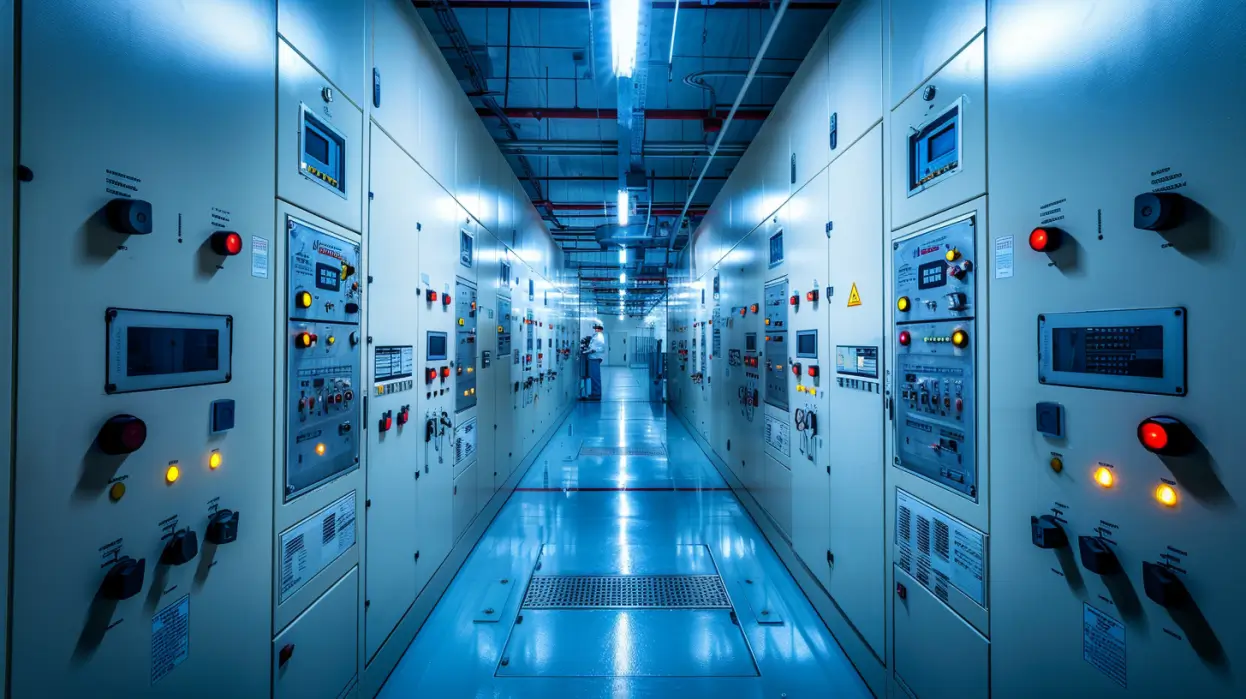
In today’s rapidly evolving power infrastructure, low-voltage switchgear plays a critical role in ensuring the safe and efficient distribution of electricity across industrial, commercial, and public sectors. Whether you're managing a metro station’s control room or designing the electrical system for a smart building, choosing the right type of switchgear is essential for both safety and system reliability.
But with so many options—air circuit breakers, molded case circuit breakers, contactor-based assemblies, and more—understanding the different low voltage switchgear types can feel overwhelming.
In this guide, we’ll break down the most common low-voltage switchgear types, explain how they work, and help you determine which solution best fits your application. By the end, you'll be better equipped to make informed decisions about your power distribution system.
Low-voltage switchgear refers to a set of electrical devices used to control, protect, and isolate electrical equipment operating at voltages of up to 1,000 volts AC (or 1,500 volts DC). It forms the backbone of many electrical distribution systems, managing how electricity is distributed from main power sources to various loads such as lighting, HVAC, machinery, or IT systems.
At its core, low-voltage switchgear serves three critical functions:
These systems are essential across sectors like:
Depending on your needs—whether compactness, modularity, remote monitoring, or safety compliance—different types of low voltage switchgear can be deployed to meet performance and regulatory requirements.
There are several types of low-voltage switchgear, each designed to perform specific functions within a power distribution system. The choice depends on factors like current capacity, protection needs, environmental conditions, and system complexity.

Here are the most commonly used low-voltage switchgear types:
Air circuit breakers are heavy-duty switchgear components typically used in the main incoming section of low voltage distribution boards. They protect circuits from overloads and short circuits by interrupting current using air as the arc extinguishing medium.
Key Features:
Applications: Industrial power centers, substations, large commercial buildings
MCCBs offer reliable protection for circuits with medium to high current levels. They are compact, versatile, and widely used in distribution panels and sub-distribution boards.
Key Features:
Applications: Panelboards, backup generators, industrial machinery
Designed for low current applications, MCBs are used to protect lighting circuits and small electrical loads. They are often installed in residential and commercial electrical panels.
Key Features:
Applications: Lighting, outlets, small office systems

Also known as Residual Current Circuit Breakers (RCCBs), these devices detect earth leakage currents and disconnect the circuit to prevent electric shock or fire.
Key Features:
Applications: Bathrooms, kitchens, data centers, schools
Contactors are electrically controlled switches used for switching motors, capacitors, or heating systems. In switchgear assemblies, they enable automated control of high-load circuits.
Key Features:
Applications: Motor Control Centers (MCCs), HVAC systems, pump stations
This modular switchgear design allows individual functional units (like breakers or contactors) to be withdrawn without de-energizing the system—making it ideal for critical operations.
Key Features:
Applications: Power plants, data centers, rail systems, airports
To help clarify the differences, here’s a side-by-side comparison of the most common low-voltage switchgear types:
| Type | Voltage Range | Current Capacity | Primary Use Case | Key Features |
|---|---|---|---|---|
| ACB | Up to 690V | Up to 6300A | Main incoming distribution | High interrupting capacity, adjustable, supports smart monitoring |
| MCCB | Up to 690V | Up to 1600A | Feeder and sub-main circuits | Compact, thermal-magnetic protection |
| MCB | Up to 400V | Up to 100A | Final circuits (lighting, small loads) | Fast trip response, easy reset |
| RCD/RCCB | Up to 400V | Up to 63A | Personal protection, leakage detection | Prevents electric shock, sensitive trip |
| Contactor Assemblies | Varies | Varies | Motor control, automation | Remote switching, high durability |
| Withdrawable Gear | Up to 690V | Customizable | Critical infrastructure | Modular, maintainable without shutdown |

Selecting the correct type of low-voltage switchgear is essential for system reliability, personnel safety, and long-term maintainability. Here are the key factors to consider:
Understand the voltage and current levels of the equipment or circuit to be protected. Higher loads typically require ACBs or MCCBs, while lighting or small equipment circuits may only need MCBs.
The installation environment matters a lot. For areas exposed to dust, humidity, heat, or vibration, such as industrial plants or outdoor enclosures, choose switchgear with robust insulation, high ingress protection (IP) ratings, and corrosion-resistant materials.
Critical places like hospitals, metro systems, or data centers, which demand continuous uptime, may benefit from modular or withdrawable switchgear designs that allow maintenance without interrupting power.
In areas where safety is crucial (homes, schools), residual current devices (RCDs) protect against electric shock. Industrial setups usually need overload, short circuit, and ground fault protection, provided by MCCBs or ACBs. Motor and automation control require contactors and relays.
If space is tight, compact MCCBs or modular panels save room. If you expect system growth, modular or intelligent switchgear with withdrawable units makes future upgrades easier and minimizes downtime.
Ensure the switchgear complies with IEC 61439 or relevant GB standards. CONYA’s solutions are engineered to meet global and regional certifications for industrial and infrastructure deployment.

Low-voltage switchgear is used across industries to ensure power distribution is both safe and efficient. Below are some of the most common environments where each type of switchgear plays a key role:
Switchgear controls power for lighting, signaling, and ventilation in tunnels and stations. Withdrawable designs allow maintenance without stopping service. ACBs and MCCBs handle high-current feeders from substations.
MCCBs and contactors protect and control heavy machinery and automation lines. MCBs cover lighting and small loads, while residual current devices ensure worker safety in harsh environments.
Reliable switchgear like ACBs with smart monitoring ensures continuous power. Modular, withdrawable units reduce downtime during maintenance. RCDs protect sensitive equipment from leakage faults.
MCBs manage lighting and power circuits floor by floor. MCCBs handle HVAC systems, elevators, and backup power. Integration with building management systems helps optimize energy use.
DC MCCBs and contactors are used in solar combiner boxes and battery storage. ACBs manage grid connections. Intelligent switchgear monitors real-time energy flow for efficient operation.
A: Common types include Air Circuit Breakers (ACBs), Molded Case Circuit Breakers (MCCBs), Miniature Circuit Breakers (MCBs), Residual Current Devices (RCDs), contactor-based assemblies, and withdrawable switchgear units. Each serves specific purposes based on load, protection needs, and system design.
A: Low-voltage switchgear is used in industrial facilities, metro systems, data centers, commercial buildings, and renewable energy systems. It ensures safe distribution, protection, and control of electrical power under 1000 volts AC.
A: MCBs are designed for lower current applications (up to ~100A) like lighting and residential circuits. MCCBs handle higher current (up to ~1600A) and offer adjustable protection settings for industrial and commercial use.
A: Consider your system’s load capacity, environmental conditions, protection needs, and future scalability. For high-reliability applications like metro or data centers, intelligent or modular switchgear like withdrawable units may be ideal.
A: International standards like IEC 61439 and regional GB standards regulate design, safety, and performance. CONYA’s switchgear products are engineered to meet or exceed these benchmarks.
Understanding the types of low voltage switchgear is more than a technical formality—it’s a critical step in designing reliable, scalable, and safe power systems. Whether you’re working on a metro expansion project, a smart office tower, or a solar farm, choosing the right equipment ensures long-term efficiency and compliance.
At CONYA, we specialize in custom-engineered low voltage switchgear solutions that combine intelligent control, robust protection, and industry-standard compliance. From prefabricated substations to intelligent distribution cabinets, our systems are trusted across transit, energy, infrastructure, and commercial sectors.
Need help selecting the right switchgear for your next project? Contact our technical team for a free consultation or download our latest product catalog for detailed specifications.